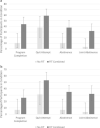Partner-Involved Financial Incentives for Smoking Cessation in Dual-Smoker Couples: A Randomized Pilot Trial
- PMID: 37742229
- PMCID: PMC10803114
- DOI: 10.1093/ntr/ntad183
Partner-Involved Financial Incentives for Smoking Cessation in Dual-Smoker Couples: A Randomized Pilot Trial
Abstract
Introduction: Members of dual-smoker couples (in which both partners smoke) are unlikely to try to quit smoking and are likely to relapse if they do make an attempt. The purpose of this study was to investigate the feasibility, tolerability, and preliminary outcomes of dyadic adaptations of financial incentive treatments (FITs) to promote smoking cessation in dual-smoker couples.
Aims and methods: We enrolled 95 dual-smoker couples (N = 190) in a three-arm feasibility RCT comparing two partner-involved FITs (single vs. dual incentives) against a no-treatment control condition. Participants in all conditions were offered nicotine replacement and psychoeducation. A 3-month follow-up provided information about retention, tolerability (ie, self-reported benefits and costs of the study), and preliminary efficacy (ie, program completion, quit attempts, point-prevalent abstinence, and joint quitting).
Results: Results suggest dyadic adaptations were feasible to implement (89% retention rate) and highly tolerable for participants (p < .001). Neither feasibility nor tolerability varied across the treatment arm. Preliminary efficacy outcomes indicated partner-involved FITs have promise for increasing smoking cessation in dual-smoker couples (OR = 2.36-13.06).
Conclusions: Dyadic implementations of FITs are feasible to implement and tolerable to participants.
Implications: The evidence that dyadic adaptations of FITs were feasible and tolerable, and the positive preliminary efficacy outcomes suggest that adequately powered RCTs formally evaluating the efficacy of dyadic adaptations of FITs for dual-smoker couples are warranted.
© The Author(s) 2023. Published by Oxford University Press on behalf of the Society for Research on Nicotine and Tobacco. All rights reserved. For permissions, please e-mail: journals.permissions@oup.com.
Conflict of interest statement
JM is a principal and senior scientist in Beam Diagnostics, Inc. and has served as a consultant to Clairvoyant Therapeutics, Inc. No other authors have disclosures.
Figures


References
-
- National Center for Chronic Disease Prevention and Health Promotion (US) Office on Smoking and Health. The Health Consequences of Smoking—50 Years of Progress: A Report of the Surgeon General. Centers for Disease Control and Prevention (US); 2014.http://www.ncbi.nlm.nih.gov/books/NBK179276/. Accessed October 14, 2022. - PubMed
-
- Fitzsimons GM, Finkel EJ, vanDellen MR.. Transactive goal dynamics. Psychol Rev. 2015;122(4):648–673. - PubMed
-
- vanDellen MR. Health behavior change in transactive systems. Soc Personal Psychol Compass. 2019;13(11). doi:10.1111/spc3.12505. - DOI
Publication types
MeSH terms
Grants and funding
LinkOut - more resources
Full Text Sources
Medical

